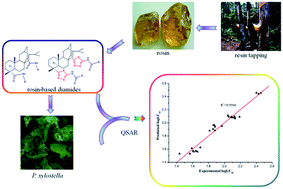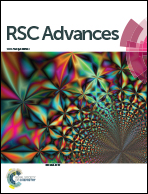Synthesis and quantitative structure–activity relationship (QSAR) studies of novel rosin-based diamide insecticides†
Abstract
In a continuing effort to develop novel natural product-based insecticidal agents endowed with low mammalian toxicity, two series of rosin-based diamides have been synthesized, and their insecticidal activities against Plutella xylostella and Mythimna separata were evaluated. Most of the synthesized compounds exhibited moderate to significant insecticidal activity. Among them, thiadiazole-containing diamides 6a–n displayed better activity than others, especially compounds 6f and 6n which exhibited excellent insecticidal activity against P. xylostella, with LC50 values of 0.223 and 0.214 mg L−1, respectively, which approximate to, or are lower than that of, the control flubendiamide (0.222 mg L−1). The preliminary structure–activity relationship analysis indicated that rosin-based diamides with electron-withdrawing groups on the benzene ring showed better insecticidal activity than those with electron-donating groups. Via a best multilinear regression analysis, the generated quantitative structure–activity relationship (QSAR) model (R2 = 0.9566) revealed a strong correlation of insecticidal activity against P. xylostella with molecular structures of these compounds. These consequences can be expected to instruct the design and development of new rosin-based insecticides.


 Please wait while we load your content...
Please wait while we load your content...